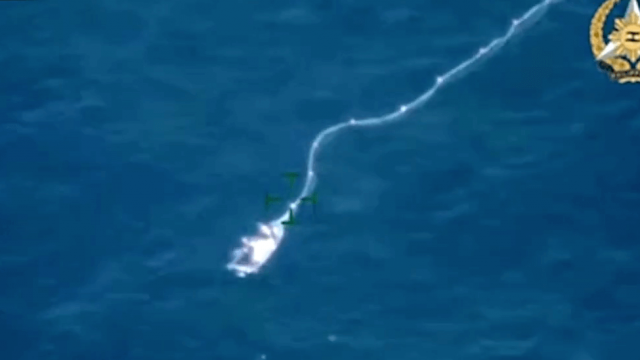MANILA, Philippines — Amid the sun-drenched waters of the West Philippine Sea, the Chinese Coast Guard, in a calculated assertion of territorial dominance, orchestrated the deployment of an extensive network of floating barriers partially encircling Ayungin Shoal, a tactically significant but contentious maritime feature. This deliberate action, aimed at obstructing essential Philippine supply runs, not only underscored the intensifying sovereignty disputes in the region but also resulted in the inadvertent entrapment of Filipino troops stationed on the shoal, thereby exacerbating the geopolitical tension and spotlighting the complex web of claims and counterclaims that beset these contested waters.
The Chinese Coast Guard as seen in the surveillance video provided by the Armed Forces of the Philippines, has started deploying a network of floating barriers around the periphery of Ayungin Shoal, a contested maritime feature, with the clear intention of thwarting any attempts by the Philippines to conduct resupply missions to its military personnel stationed there, effectively isolating them and challenging established norms of freedom of navigation in the region, thereby not only asserting China’s controversial maritime claims but also testing the resolve of other nations vested in maintaining a rules-based international order in one of the world’s busiest waterways.
Chinese coast guard ships hit a Philippine supply boat with water cannons Saturday in the latest confrontation near a disputed shoal in the West Philippine Sea, causing injuries to its navy crew members and heavy damage to the wooden vessel, Philippine officials said.
The United States and Japan immediately expressed their support to the Philippines, as well as alarm over Chinese forces’ aggression off the Second Thomas Shoal, which has been the scene of repeated confrontations between Chinese and Philippine vessels over the past year.
The far-flung shoal has been occupied by a small contingent of Philippine navy and marines on a marooned warship since 1999, but has been surrounded by Chinese coast guard and suspected militia vessels in an increasingly tense territorial standoff. It’s the second time the Philippine boat Unaizah May 4 has been damaged by the Chinese coast guard’s water cannon assault in March alone.
The repeated high-seas confrontations have sparked fears they could degenerate into a larger conflict that could bring China and the United States into a collision.
Washington lays no claims to the busy seaway, a key global trade route, but has deployed Navy ships and fighter jets in what it calls “freedom of navigation” operations, which China has criticized.
The U.S. has also warned repeatedly that it’s obligated to defend the Philippines — its oldest treaty ally in Asia — if Filipino forces, ships or aircraft come under an armed attack, including in the South China Sea.
U.S. State Department spokesperson Matthew Miller said in a statement Saturday that the United States “stands with its ally the Philippines and condemns the dangerous actions by the People’s Republic of China (PRC) against lawful Philippine maritime operations in the South China Sea on March 23.”
He said the Chinese ships’ “repeated employment of water cannons and reckless blocking maneuvers resulted in injuries to Filipino service members and significant damage to their resupply vessel, rendering it immobile.”
READ: China now claims Gulf of Tonkin which Vietnam owns, renaming it Beibu Gulf


